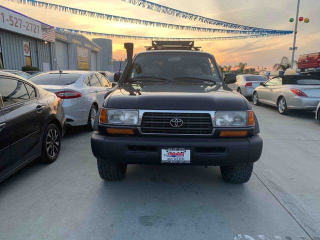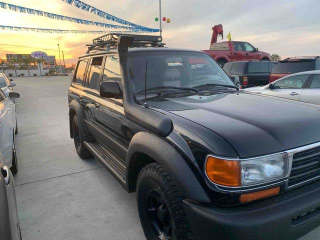The Good
The 1996 Toyota Land Cruiser boasts legendary reliability and exceptional off-road performance, appealing to adventurers and practical buyers alike. Its spacious and comfortable interior, combined with a timeless, rugged design, provides both emotional satisfaction and practical utility. Despite modest fuel efficiency, its incredible durability and strong resale value ensure excellent long-term ownership value.
The Bad
While robust, the 1996 Land Cruiser has known weaknesses. Its fuel economy is notably poor, and rust can be a significant issue, particularly on frames and body panels in corrosive climates. Watch out for worn suspension components, potential steering issues, and age-related electrical problems. The 4.5L engine, while reliable, can feel underpowered for its hefty weight, leading to slower acceleration.
1996 Toyota Land Cruiser: Quick Overview
The 1996 Toyota Land Cruiser (FZJ80) is known for its robust and capable specifications:
- Engine: It features a single, powerful engine option for the North American market: the 4.5-liter 1FZ-FE inline-six cylinder, a highly durable and torquey engine renowned for its longevity.
- Horsepower: This engine produced approximately 212 horsepower at 4,600 rpm and 275 lb-ft of torque at 3,200 rpm, providing ample power for off-road excursions and highway cruising, albeit not for rapid acceleration.
- Fuel Economy: Fuel efficiency is not a strong suit, with EPA estimates typically around 13 MPG in the city and 15 MPG on the highway. This is a common consideration for potential owners.
- 0-60 MPH Acceleration: Due to its considerable curb weight and focus on durability over speed, the 0-60 MPH acceleration time is leisurely, usually ranging from 10 to 12 seconds.
- Towing Capacity: The 1996 Land Cruiser offers a respectable towing capacity of approximately 5,000 pounds when properly equipped, making it capable of hauling trailers, boats, or other recreational gear.
- Transmission: Typically paired with a 4-speed automatic transmission, known for its robustness.
- Drivetrain: Equipped with a full-time four-wheel-drive system with a two-speed transfer case (high/low range).
- Trim-Level Features: North American models often came in a single, well-appointed trim. Standard features included power windows and locks, air conditioning, cruise control, an AM/FM cassette stereo, and anti-lock brakes (ABS). Optional, and highly sought-after features, included leather upholstery, a power sunroof, and critically, factory front and rear locking differentials, which dramatically enhance its off-road capability. Other options might include a third-row seat, running boards, and alloy wheels. These features solidified its reputation as a premium and extremely capable SUV.
1996 Toyota Land Cruiser Specifications
Vehicle Information
| Year | 1996 |
| Make | Toyota |
| Model | Land Cruiser |
| Trim | - |
| Style | 4WD |
| Type | Sport Utility Vehicle |
| Category | Standard Sport Utility Vehicle |
Manufacturing Details
| Made In | Japan |
| Manufacturing City | TOYOTA CITY |
Dimensions
| Doors | 4-Door |
| Curb Weight | 4751 pounds |
| Gross Vehicle Weight Rating | 7000 pounds |
| Overall Height | 73.20 inches |
| Overall Length | 189.80 inches |
| Overall Width | 76.00 inches |
| Wheelbase Length | 112.20 inches |
| Standard Seating | 5 |
Engine & Performance
| Engine | 4.5-L L-6 DOHC 24V |
| Engine Size | 4.5L |
| Engine Cylinders | 6 |
| Transmission | 4-Speed Automatic |
| Transmission Type | Automatic |
| Transmission Speeds | 4-Speed |
| Drivetrain | Four-Wheel Drive |
Additional Features
| Anti-Brake System | 4-Wheel ABS |
| Steering Type | Recirculating |
Pricing
| Manufacturer Suggested Retail Price (MSRP) | $40,258 |
| Invoice Price | - |
| Delivery Charges | - |
Vehicle History Report
Specifications
History
Events
History Check
Check
Check
Check
Check
Listings
Recalls
Check
Analysis
What Problems Does the 1996 Toyota Land Cruiser Have?
Rust is a pervasive long-term concern, especially for vehicles from regions that experience harsh winters and use road salt. Owners frequently report rust on the frame, rear quarter panels, tailgate, and around window seals.
Mechanical issues often involve the steering knuckle and front axle seals, which are known to leak over time, requiring regular maintenance or replacement of seals and bearing repacks. The power steering pump and its associated hoses can also develop leaks with age.
Inside, HVAC blower motors and resistors are common failure points, leading to intermittent or non-functional climate control. Rear axle bearings and the front driveshaft's U-joints also require attention and maintenance. Electrical components such as the alternator and starter, like any vehicle of this vintage, are susceptible to age-related wear. Owners should also check for proper function of the cruise control system, as its actuator can develop issues.
While specific major recalls for the 1996 model year are not extensively documented for critical drivetrain components, general service bulletins for minor items may exist. The overall consensus is that these vehicles are immensely durable, but proper, consistent maintenance is crucial to mitigating these common issues and ensuring their legendary longevity.
How long will the 1996 Toyota Land Cruiser last?
However, long-term weaknesses primarily include pervasive rust issues, especially in areas exposed to road salt, which can affect the frame, body panels, and fuel lines. Suspension components, such as bushings, shocks, and control arm mounts, naturally wear out over decades of use. Steering components, including the steering box and power steering pump, also require attention over time. Interior components and electrical accessories may show significant wear or intermittent function, but these are generally manageable concerns for a vehicle of this age. Consistent maintenance is the key to unlocking its full potential for decades of reliable service.
What Technology & Safety Features are Included?
Built-in Tech & Convenience: Standard features included power windows, power door locks, power-adjustable side mirrors, and cruise control. Air conditioning was standard, often with front and rear climate controls, making it comfortable for all occupants. A tilt steering wheel and intermittent wipers were also common.
Entertainment: The standard entertainment system consisted of an AM/FM radio with a cassette player. A multi-disc CD changer was typically an optional accessory or a dealer-installed item. Sound quality was reasonable for the time, often with a premium audio option.
Driver-Assistance & Safety Features: Driver-assistance technology was rudimentary by modern standards. The most significant feature was the standard Anti-lock Braking System (ABS), which improved braking control on slippery surfaces. Safety features included dual front airbags for both the driver and front passenger, along with three-point seat belts for all outboard seating positions. Side airbags, electronic stability control, or traction control systems were not available.
Optional Features: Beyond the standard fare, popular optional features included luxurious leather upholstery, a power-operated sunroof, and a third-row bench seat to increase passenger capacity. For enthusiasts and serious off-roaders, the most coveted option was the factory-installed front and rear locking differentials, which dramatically enhanced the vehicle's ability to traverse extremely challenging terrain.
Crash-Test Ratings: Comprehensive crash-test ratings from organizations like NHTSA or IIHS in their modern format are generally unavailable for vehicles of this vintage. While the Land Cruiser was built with robust frame-on-body construction, specific detailed crash performance metrics comparable to contemporary vehicles are not published.
What Colors Options are Available?
1996 Toyota Land Cruiser Prices and Market Value
Unlike many vehicles, the Land Cruiser exhibits remarkably low depreciation, with values often stabilizing and even appreciating over time for well-preserved examples. Factors profoundly affecting resale value include the overall physical condition, the presence of rust (a major deterrent), comprehensive maintenance records, mileage, and crucially, whether it has the factory "triple-locked" differential option. Modifications can also impact value; tasteful and functional upgrades often add value, while poorly executed or excessive mods can detract from it. Its reputation for longevity ensures a strong and enduring market.
1996 Toyota Land Cruiser Cost of Ownership
Maintenance is crucial and can be expensive if relying solely on dealerships, but many routine tasks are DIY-friendly. Parts, while durable, can sometimes be specific and thus pricey. Common age-related repairs, like addressing rust or worn suspension/steering components, can add up. While the initial purchase might seem economical for its capability, be prepared for ongoing expenses, especially for fuel and age-related maintenance to keep this classic running reliably for decades.
1996 Toyota Land Cruiser Fuel Efficiency
1996 Toyota Land Cruiser Safety Rating
NHTSA
IIHS
1996 Toyota Land Cruiser Warranty
Basic
Powertrain
Rust
1996 Toyota Land Cruiser Insurance
reasonable repair costs.
How Does the 1996 Toyota Land Cruiser Compare to Other Sport Utility Vehicle?
In terms of performance, especially off-road, the Land Cruiser is a titan. While the Range Rover P38 offered comparable theoretical off-road capability with its air suspension and sophisticated AWD, its practical reliability for long-term arduous use paled in comparison to the Land Cruiser's mechanical simplicity and brute strength. The Grand Cherokee was more agile and perhaps more comfortable on-road but lacked the Land Cruiser's robust frame and heavy-duty drivetrain for extreme expeditions. American full-size SUVs were larger and offered V8 power but were generally less purpose-built for serious off-road endeavors and long-term global reliability.
Features on the Land Cruiser were solid for the era, focusing on durability and utility, with desirable options like locking differentials. The Range Rover was arguably more luxurious with advanced electronic amenities, but these often became sources of notorious electrical and air suspension failures.
Reliability is where the Land Cruiser truly dominates. Its "go-anywhere, come-back" reputation is largely unmatched by any of its direct competitors from the same vintage. The Land Rover's complex systems often led to significant repair costs and downtime, while the Grand Cherokee, though popular, didn't boast the same long-term durability.
Regarding price, the Land Cruiser's new price was competitive with the Range Rover. However, its depreciation has been significantly lower. Used Land Cruisers consistently command higher prices than comparable Range Rovers or Grand Cherokees of the same year due to their legendary reliability and enduring demand.
Alternatives: For someone seeking similar bulletproof reliability and extreme off-road capability, the Land Cruiser (or its luxury twin, the Lexus LX 450) is the benchmark. If absolute reliability and off-road prowess are paramount, there are few better alternatives from this era. For those prioritizing on-road comfort and less extreme off-roading, a newer generation Toyota 4Runner or even a Lexus GX from a later period might be considered, but for its specific blend of ruggedness and longevity, the 80-series Land Cruiser remains unique.
Final Verdict: Is the 1996 Toyota Land Cruiser a Good Sport Utility Vehicle?
It is absolutely worth buying, but exclusively as a used vehicle, given its age. Prospective buyers should prioritize examples with comprehensive maintenance records, minimal rust (especially on the frame), and ideally, the coveted factory front and rear locking differentials. Be prepared for higher fuel costs and age-related maintenance, but in return, you get a vehicle that can genuinely last for decades and hold its value remarkably well. It's an investment in a piece of automotive legend that, with proper care, will deliver unwavering service and adventure.

